what was the prevailing belief prior to the time of lyell
The acceptance of biological evolution ![]() is an essential role of the modern scientific explanation of the natural world. Near scientists and major religions in the Western Earth have long since incorporated it into their agreement of nature and humanity. However, some churches still maintain that in that location was a special and independent cosmos of every species and that life forms do not change through time from generation to generation. These "creationists" often share behavior nigh the Judeo-Christian Bible that were widely held, even by scientists, during the early 19th century and before.
is an essential role of the modern scientific explanation of the natural world. Near scientists and major religions in the Western Earth have long since incorporated it into their agreement of nature and humanity. However, some churches still maintain that in that location was a special and independent cosmos of every species and that life forms do not change through time from generation to generation. These "creationists" often share behavior nigh the Judeo-Christian Bible that were widely held, even by scientists, during the early 19th century and before.
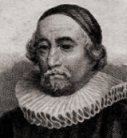 | |
| James Ussher |
The traditional Judeo-Christian version of creationism ![]() was strongly reinforced by James Ussher
was strongly reinforced by James Ussher ![]() , a 17th century Anglican archbishop of Armagh in Northern Ireland. Past counting the generations of the Bible and adding them to modern history, he fixed the engagement of creation at Oct 23, 4004 B.C. During Ussher's lifetime, debate focused only on the details of his calculations rather than on the approach. Dr. Charles Lightfoot of Cambridge Academy in England had the last word. He proclaimed that the time of creation was 9:00 A.M. on October 23, 4004 B.C.
, a 17th century Anglican archbishop of Armagh in Northern Ireland. Past counting the generations of the Bible and adding them to modern history, he fixed the engagement of creation at Oct 23, 4004 B.C. During Ussher's lifetime, debate focused only on the details of his calculations rather than on the approach. Dr. Charles Lightfoot of Cambridge Academy in England had the last word. He proclaimed that the time of creation was 9:00 A.M. on October 23, 4004 B.C.
This belief that the world and life on it are only virtually 6000 years erstwhile fit neatly with the then prevalent theory of the "Not bad Chain of Being." This held that God created an infinite and continuous series of life forms, each one grading into the next, from simplest to most complex, and that all organisms, including humans, were created in their nowadays form relatively recently and that they accept remained unchanged since so. Given these strongly held behavior, information technology is not surprising that 17th and 18th century European biological science consisted mainly of the description of plants and animals equally they are with near no attempt to explain how they got to be that manner.
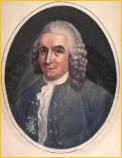 | |
| Carolus Linnaeus 1707-1778 |
The leading biological scientist of the mid 18th century was the Swedish botanist Karl von Linn� ( Carolus Linnaeus ![]() in Latin). His 180 books are filled with precise descriptions of nature, but he did petty assay or interpretation. This is to exist expected since Linnaeus apparently believed that he was just revealing the unchanging society of life created by God. The goal of documenting modify in nature would not have made sense to him. Belatedly in his life, nonetheless, he was troubled by the fact that plant hybrids could be created by cross pollination. These were varieties that had non existed earlier. Linnaeus stopped curt of final that these plants had evolved.
in Latin). His 180 books are filled with precise descriptions of nature, but he did petty assay or interpretation. This is to exist expected since Linnaeus apparently believed that he was just revealing the unchanging society of life created by God. The goal of documenting modify in nature would not have made sense to him. Belatedly in his life, nonetheless, he was troubled by the fact that plant hybrids could be created by cross pollination. These were varieties that had non existed earlier. Linnaeus stopped curt of final that these plants had evolved.
Despite his limiting research bias, Linnaeus was a get-go course scientist. His most important contribution to science was his logical nomenclature system for all living things which he proposed in his book Systema Naturae, first published in 1735. In this and subsequent works, he described plants and animals on the basis of physical appearance and method of reproduction. He classified them relative to each other according to the degree of their similarities. He used a binomial classification ![]() in naming them. That is to say, organisms were given 2 Latin names--genus
in naming them. That is to say, organisms were given 2 Latin names--genus ![]() and species
and species ![]() . Each genus could have many related species. Each genus was too part of larger categories of living things. This Linnaean system of classification is today the ground for naming and describing organisms in all fields of biology.
. Each genus could have many related species. Each genus was too part of larger categories of living things. This Linnaean system of classification is today the ground for naming and describing organisms in all fields of biology.
| genus | genus | ||
|---|---|---|---|
| species | species | species | species |
 | |
| John Ray |
The concept of genus and species was actually developed in the belatedly 1600'south by John Ray, an English naturalist and ordained minister. However, it was Linnaeus who used this organization to name us Homo sapiens ![]() (literally, "wise men"). He likewise placed us in the guild Primates (a larger, more inclusive category than our genus) along with all of the apes, monkeys, and prosimians. This was very controversial at the time since it implied that people were part of nature, along with other animals and plants. In improver, it meant that we were biologically closer to the other primates than to all other animals.
(literally, "wise men"). He likewise placed us in the guild Primates (a larger, more inclusive category than our genus) along with all of the apes, monkeys, and prosimians. This was very controversial at the time since it implied that people were part of nature, along with other animals and plants. In improver, it meant that we were biologically closer to the other primates than to all other animals.
| | |
| Comte de Buffon 1707-1788 |
Late in the 18th century, a small number of European scientists began to quietly suggest that life forms are not stock-still. The wealthy French mathematician and naturalist, George Louis Leclerc, Comte de Buffon ![]() , actually said that living things do change through time. He speculated that this was somehow a result of influences from the environment or even chance. He believed that the globe must exist much older than 6000 years. In 1774, in fact, he speculated that the world must be at least 75,000 years old. He besides suggested that humans and apes are related. Buffon was conscientious to hide his radical views in a limited edition 44 volume natural history volume series called Histoire Naturelle (1749-1804) . By doing this, he avoided broad public criticism.
, actually said that living things do change through time. He speculated that this was somehow a result of influences from the environment or even chance. He believed that the globe must exist much older than 6000 years. In 1774, in fact, he speculated that the world must be at least 75,000 years old. He besides suggested that humans and apes are related. Buffon was conscientious to hide his radical views in a limited edition 44 volume natural history volume series called Histoire Naturelle (1749-1804) . By doing this, he avoided broad public criticism.
Buffon was an early on advocate of the Linnaean classification system. He was also a quiet pioneer in asserting that species tin can change over generations. However, he publicly rejected the idea that species could evolve into other species. One of his about significant contributions to the biological sciences was his insistence that natural phenomena must exist explained past natural laws rather than theological doctrine.
 | |
| Erasmus Darwin |
Another belatedly 18th century closet-evolutionist was Erasmus Darwin ![]() , the grandfather of the well known 19th century naturalist, Charles Darwin. Erasmus was an English country physician, poet, and amateur scientist. He believed that development has occurred in living things, including humans, merely he only had rather fuzzy ideas most what might be responsible for this modify. He wrote of his ideas about development in poems and a relatively obscure ii volume scientific publication entitled Zoonomia; or, the Laws of Organic Life (1794-1796). In this latter work, he besides suggested that the earth and life on it must accept been evolving for "millions of ages before the offset of the history of mankind."
, the grandfather of the well known 19th century naturalist, Charles Darwin. Erasmus was an English country physician, poet, and amateur scientist. He believed that development has occurred in living things, including humans, merely he only had rather fuzzy ideas most what might be responsible for this modify. He wrote of his ideas about development in poems and a relatively obscure ii volume scientific publication entitled Zoonomia; or, the Laws of Organic Life (1794-1796). In this latter work, he besides suggested that the earth and life on it must accept been evolving for "millions of ages before the offset of the history of mankind."
The beginning evolutionist who confidently and very publicly stated his ideas about the processes leading to biological change was a French prot�g� of the Comte de Buffon. He was Jean-Baptiste Chevalier de Lamarck ![]() . Unfortunately, his theory about these processes was incorrect.
. Unfortunately, his theory about these processes was incorrect.
Lamarck believed that microscopic organisms announced spontaneously from inanimate materials and so transmute, or evolve, gradually and progressively into more complex forms through a constant striving for perfection. The ultimate product of this goal-oriented development was thought by Lamarck to exist humans. He believed that development was mostly due to the inheritance of acquired characteristics equally creatures adapted to their environments. That is, he believed that evolution occurs when an organism uses a body part in such a fashion that information technology is altered during its lifetime and this change is and then inherited by its offspring. For example, Lamarck idea that giraffes evolved their long necks by each generation stretching further to get leaves in trees and that this change in trunk shape was then inherited. Likewise, he believed that wading birds, such equally herons and egrets, evolved their long legs past stretching them to remain dry. Lamarck besides believed that creatures could develop new organs or alter the structure and role of quondam ones as a result of their use or decay.
| | 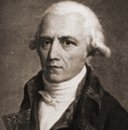 | |
| Lamarck's incorrect idea of the crusade of evolution | Jean-Baptiste Lamarck 1744-1829 |
Lamarck did non invent the idea of inheritance of caused characteristics only stated it clearly and publicly in an 1809 publication entitled Philosophie Zoologique. Information technology was relatively easy for the French scientist, George Cuvier ![]() , and other critics of Lamarck to discredit his theory. If it was correct, the children of cowboys who have developed bowed legs every bit a result of a lifetime of riding horses would be born with bowed legs every bit well. That, of course, does not occur. Besides, the children of professional person weight lifters are not built-in with enlarged muscles.
, and other critics of Lamarck to discredit his theory. If it was correct, the children of cowboys who have developed bowed legs every bit a result of a lifetime of riding horses would be born with bowed legs every bit well. That, of course, does not occur. Besides, the children of professional person weight lifters are not built-in with enlarged muscles.
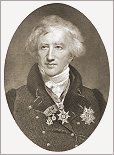 | |
| George Cuvier 1769-1832 |
While Lamarck's explanation of evolution was wrong, it is unfair to characterization him a bad scientist. In fact, he was at the cutting edge of biological research for his time. He and George Cuvier were largely responsible for making biology a distinct co-operative of scientific discipline.
Despite his criticism of Lamarck, Cuvier did not reject the idea that there had been earlier life forms. In fact, he was the outset scientist to document extinctions of ancient animals and was an internationally respected good on dinosaurs. However, he rejected the idea that their being implied that evolution had occurred--he dogmatically maintained the "fixity" of species.
Cuvier advocated the theory of catastrophism ![]() , as did near other leading scientists of his day. This held that at that place have been vehement and sudden natural catastrophes such every bit neat floods and the rapid formation of major mount chains. Plants and animals living in those parts of the world where such events occurred were oftentimes killed off according to Cuvier. And so new life forms moved in from other areas. Equally a result, the fossil record for a region shows sharp changes in species. Cuvier's explanation relied solely on scientific bear witness rather than biblical interpretation.
, as did near other leading scientists of his day. This held that at that place have been vehement and sudden natural catastrophes such every bit neat floods and the rapid formation of major mount chains. Plants and animals living in those parts of the world where such events occurred were oftentimes killed off according to Cuvier. And so new life forms moved in from other areas. Equally a result, the fossil record for a region shows sharp changes in species. Cuvier's explanation relied solely on scientific bear witness rather than biblical interpretation.
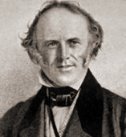 | |
| Charles Lyell 1797-1875 |
A conscientious examination of European geological deposits in the early 19th century led the English lawyer and geologist, Charles Lyell ![]() , to conclude that Cuvier'due south catastrophism theory was wrong. He believed that there primarily have been slower, progressive changes. In his three volume Principles of Geology (1830-1833), Lyell documented the fact that the earth must exist very old and that information technology has been subject to the same sort of natural processes in the past that operate today in shaping the land. These forces include erosion, earthquakes, glacial movements, volcanoes, and even the decomposition of plants and animals.
, to conclude that Cuvier'due south catastrophism theory was wrong. He believed that there primarily have been slower, progressive changes. In his three volume Principles of Geology (1830-1833), Lyell documented the fact that the earth must exist very old and that information technology has been subject to the same sort of natural processes in the past that operate today in shaping the land. These forces include erosion, earthquakes, glacial movements, volcanoes, and even the decomposition of plants and animals.
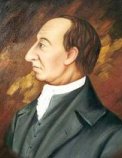 | |
| James Hutton |
Lyell provided conclusive evidence for the theory of uniformitarianism ![]() , which had been developed originally past the late 18th century Scottish geologist, James Hutton. This held that the natural forces at present changing the shape of the earth's surface have been operating in the past much the aforementioned way. In other words, the present is the key to understanding the by.
, which had been developed originally past the late 18th century Scottish geologist, James Hutton. This held that the natural forces at present changing the shape of the earth's surface have been operating in the past much the aforementioned way. In other words, the present is the key to understanding the by.
This revolutionary idea was instrumental in leading Charles Darwin to his understanding of biological evolution in the 1830'southward. However, it was not until the late 19th century that most educated people in the Western world finally rejected the theory of catastrophism in favor of uniformitarianism.
Today, we know that our planet has been shaped by occasional catastrophic events, such equally bombardment of large meteors, in add-on to the comparatively slower natural processes suggested past uniformitarianism. All of these events take potentially affected the rate and management of biological development.
NOTE : While George Cuvier and Charles Lyell strongly disagreed almost how the world got to be the way it is today, they both rejected the idea of biological evolution. Yet, neither human being accepted a traditional Biblical account of cosmos and a young earth. Cuvier did not live long plenty to learn about Charles Darwin's proof of evolution, but Lyell did. He came to have this proof in the early 1860'due south along with almost leading scientists of that time. Lyell also became a friend of Charles Darwin.
Copyright � 1998-2012 past Dennis O'Neil. All rights reserved.
illustration credits
Source: https://www2.palomar.edu/anthro/evolve/evolve_1.htm
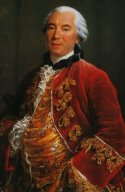
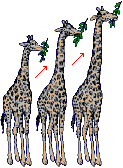
0 Response to "what was the prevailing belief prior to the time of lyell"
Post a Comment